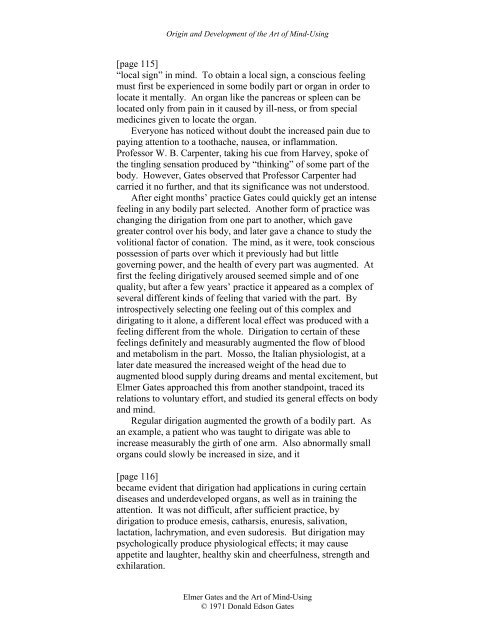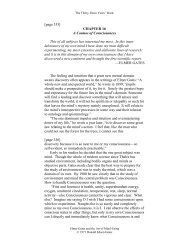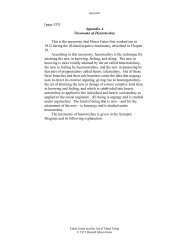Chapter 7. Attention, Dirigation, and the Newest ... - ElmerGates.com
Chapter 7. Attention, Dirigation, and the Newest ... - ElmerGates.com
Chapter 7. Attention, Dirigation, and the Newest ... - ElmerGates.com
Create successful ePaper yourself
Turn your PDF publications into a flip-book with our unique Google optimized e-Paper software.
Origin <strong>and</strong> Development of <strong>the</strong> Art of Mind-Using[page 115]“local sign” in mind. To obtain a local sign, a conscious feelingmust first be experienced in some bodily part or organ in order tolocate it mentally. An organ like <strong>the</strong> pancreas or spleen can belocated only from pain in it caused by ill-ness, or from specialmedicines given to locate <strong>the</strong> organ.Everyone has noticed without doubt <strong>the</strong> increased pain due topaying attention to a toothache, nausea, or inflammation.Professor W. B. Carpenter, taking his cue from Harvey, spoke of<strong>the</strong> tingling sensation produced by “thinking” of some part of <strong>the</strong>body. However, Gates observed that Professor Carpenter hadcarried it no fur<strong>the</strong>r, <strong>and</strong> that its significance was not understood.After eight months’ practice Gates could quickly get an intensefeeling in any bodily part selected. Ano<strong>the</strong>r form of practice waschanging <strong>the</strong> dirigation from one part to ano<strong>the</strong>r, which gavegreater control over his body, <strong>and</strong> later gave a chance to study <strong>the</strong>volitional factor of conation. The mind, as it were, took consciouspossession of parts over which it previously had but littlegoverning power, <strong>and</strong> <strong>the</strong> health of every part was augmented. Atfirst <strong>the</strong> feeling dirigatively aroused seemed simple <strong>and</strong> of onequality, but after a few years’ practice it appeared as a <strong>com</strong>plex ofseveral different kinds of feeling that varied with <strong>the</strong> part. Byintrospectively selecting one feeling out of this <strong>com</strong>plex <strong>and</strong>dirigating to it alone, a different local effect was produced with afeeling different from <strong>the</strong> whole. <strong>Dirigation</strong> to certain of <strong>the</strong>sefeelings definitely <strong>and</strong> measurably augmented <strong>the</strong> flow of blood<strong>and</strong> metabolism in <strong>the</strong> part. Mosso, <strong>the</strong> Italian physiologist, at alater date measured <strong>the</strong> increased weight of <strong>the</strong> head due toaugmented blood supply during dreams <strong>and</strong> mental excitement, butElmer Gates approached this from ano<strong>the</strong>r st<strong>and</strong>point, traced itsrelations to voluntary effort, <strong>and</strong> studied its general effects on body<strong>and</strong> mind.Regular dirigation augmented <strong>the</strong> growth of a bodily part. Asan example, a patient who was taught to dirigate was able toincrease measurably <strong>the</strong> girth of one arm. Also abnormally smallorgans could slowly be increased in size, <strong>and</strong> it[page 116]became evident that dirigation had applications in curing certaindiseases <strong>and</strong> underdeveloped organs, as well as in training <strong>the</strong>attention. It was not difficult, after sufficient practice, bydirigation to produce emesis, catharsis, enuresis, salivation,lactation, lachrymation, <strong>and</strong> even sudoresis. But dirigation maypsychologically produce physiological effects; it may causeappetite <strong>and</strong> laughter, healthy skin <strong>and</strong> cheerfulness, strength <strong>and</strong>exhilaration.Elmer Gates <strong>and</strong> <strong>the</strong> Art of Mind-Using© 1971 Donald Edson Gates





![[page i] Elmer Gates and the Art of Mind-Using ... - ElmerGates.com](https://img.yumpu.com/35274485/1/190x245/page-i-elmer-gates-and-the-art-of-mind-using-elmergatescom.jpg?quality=85)

